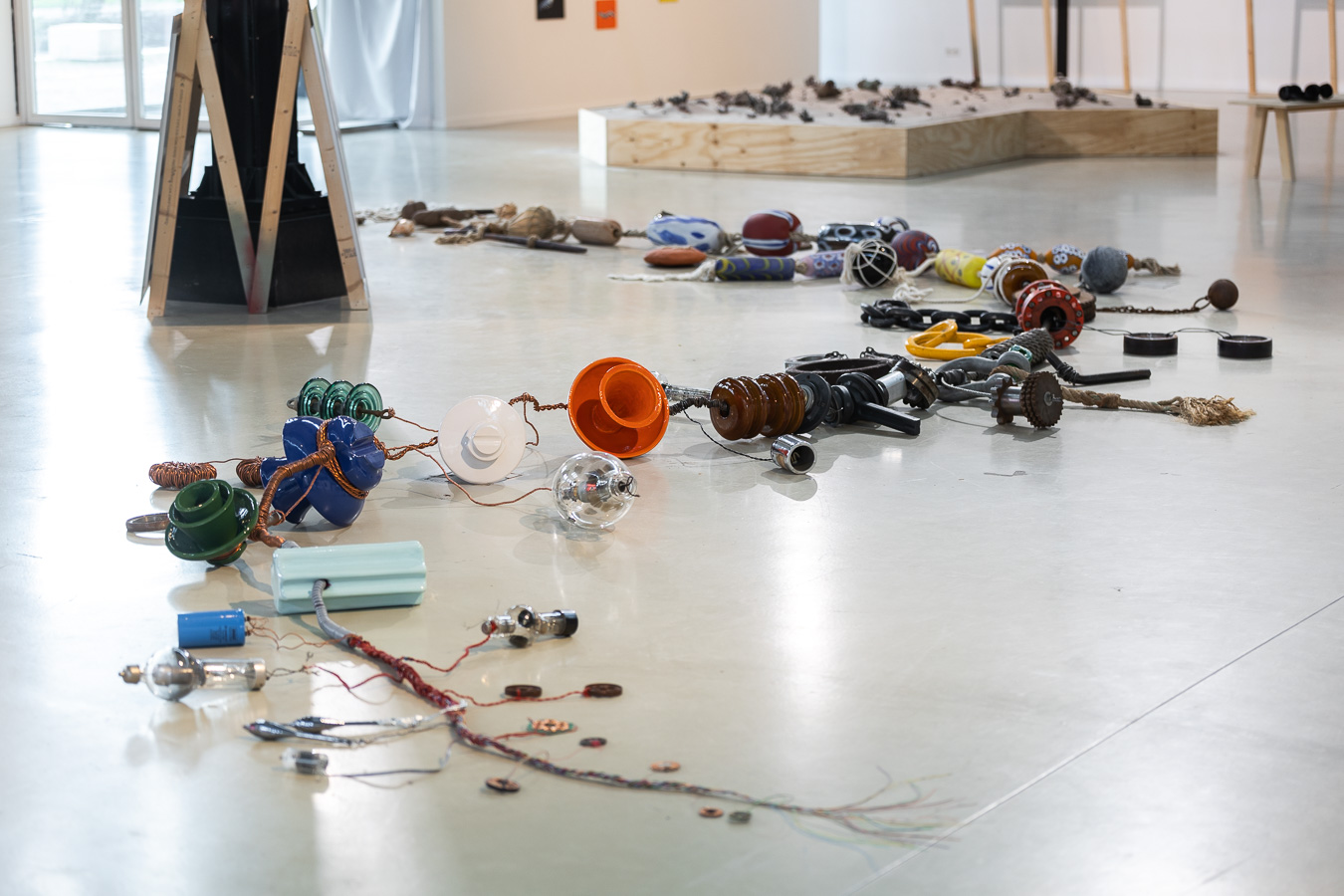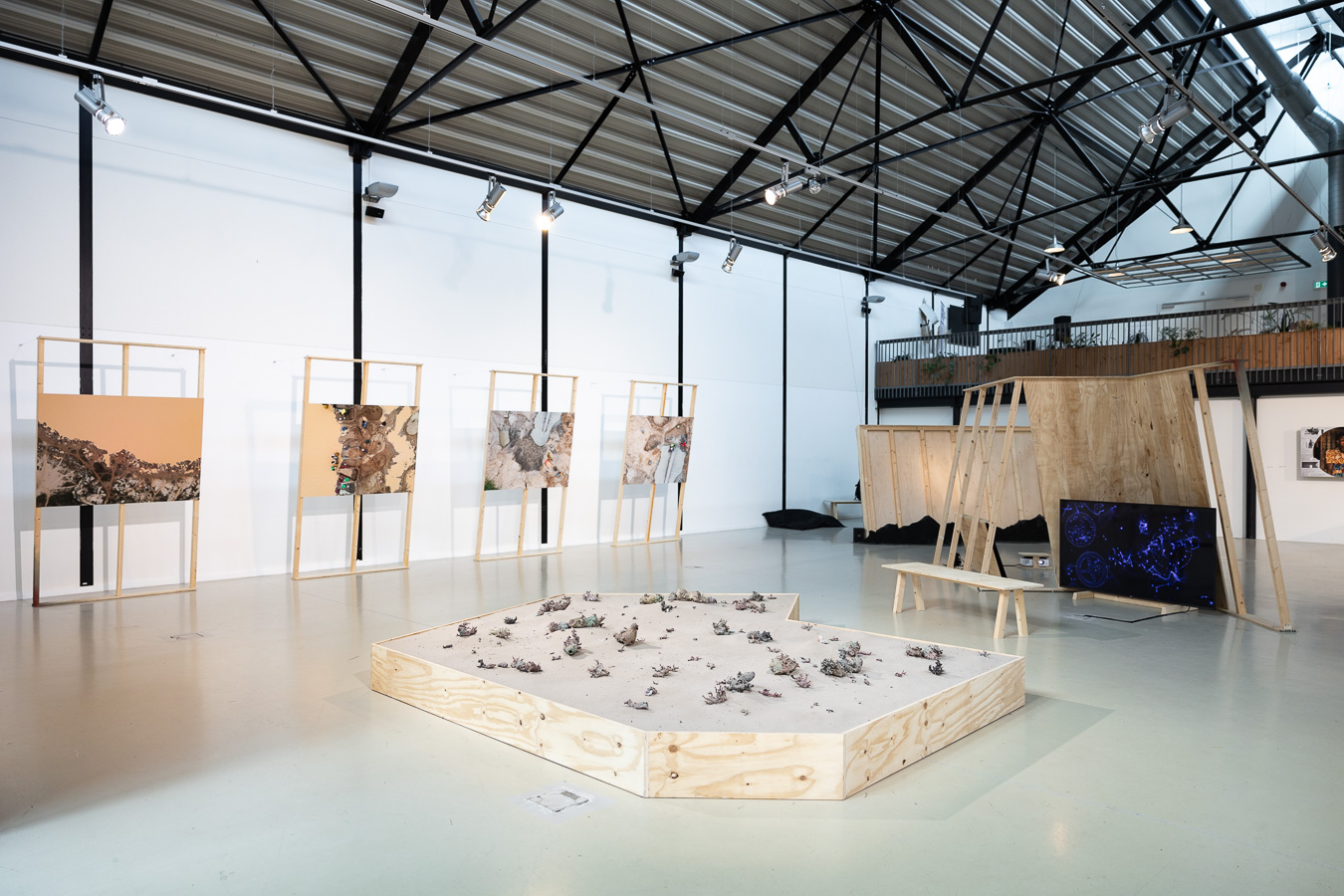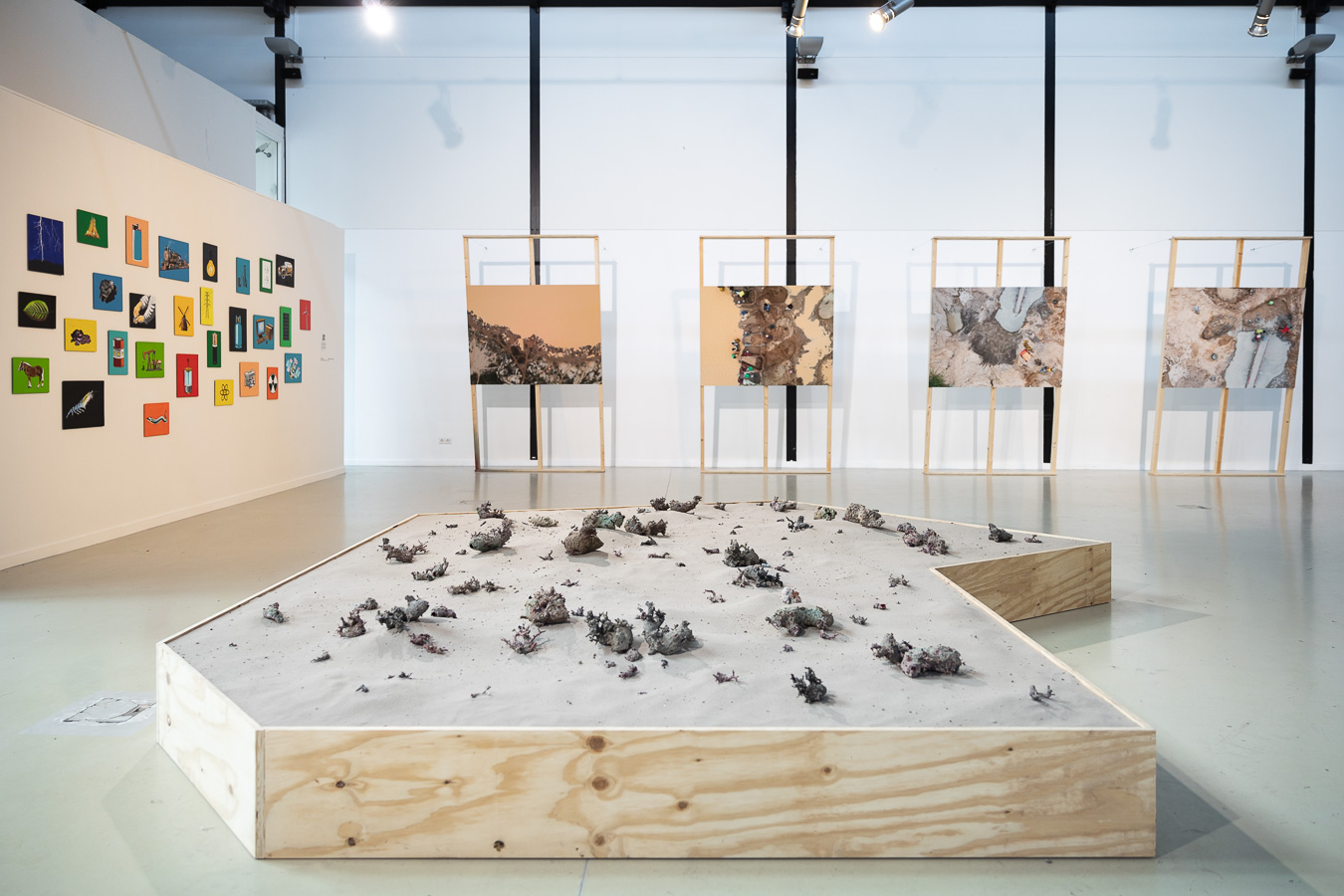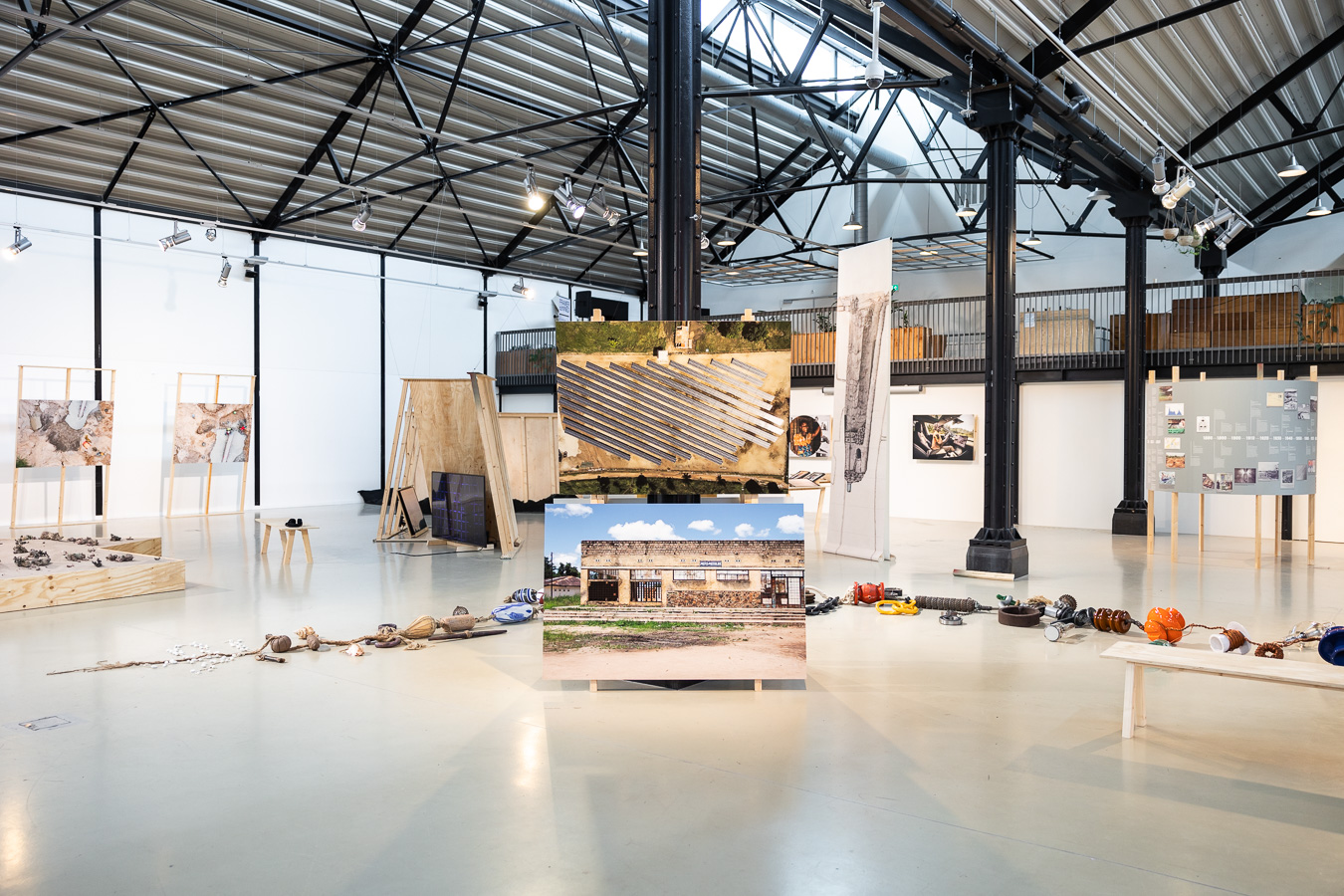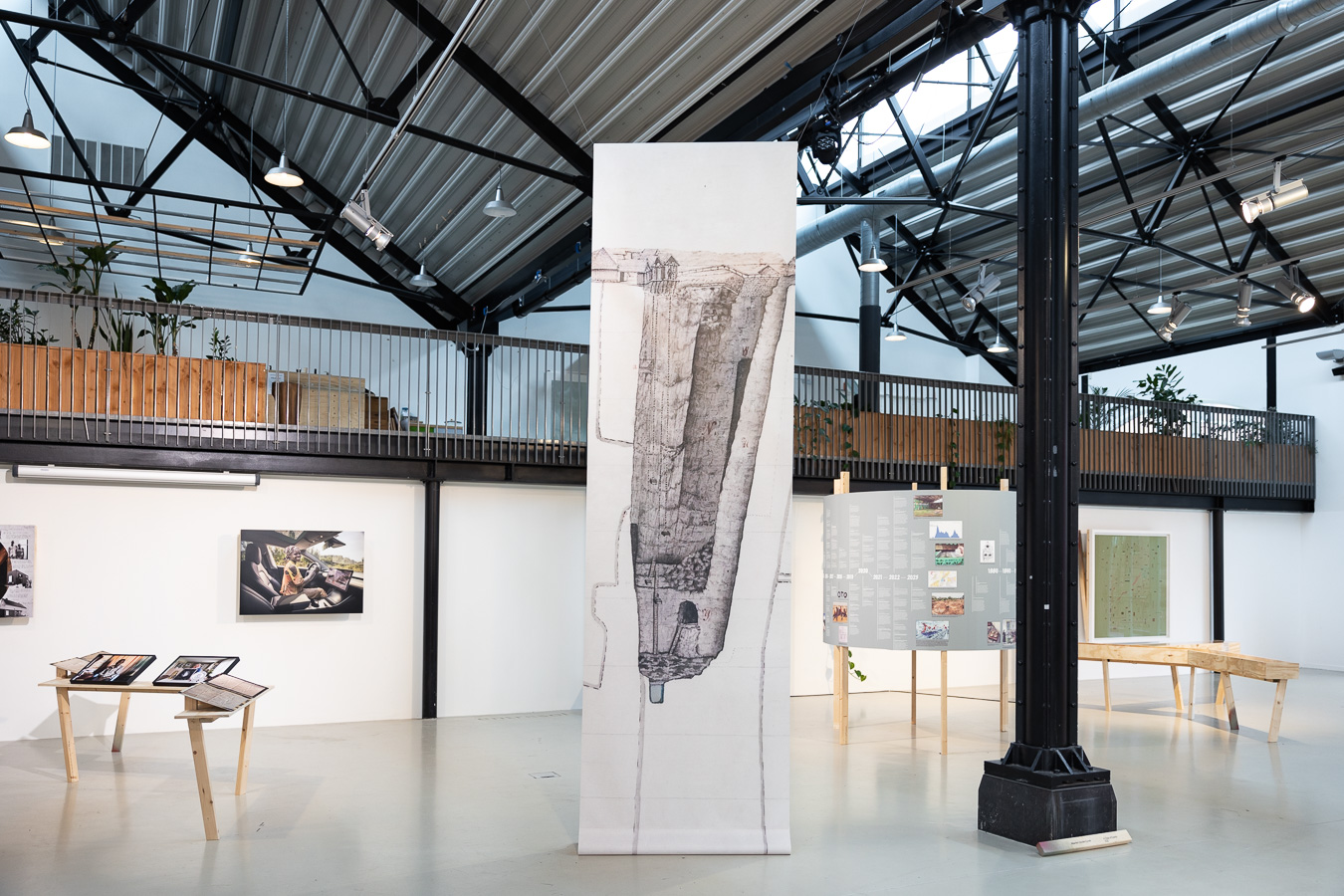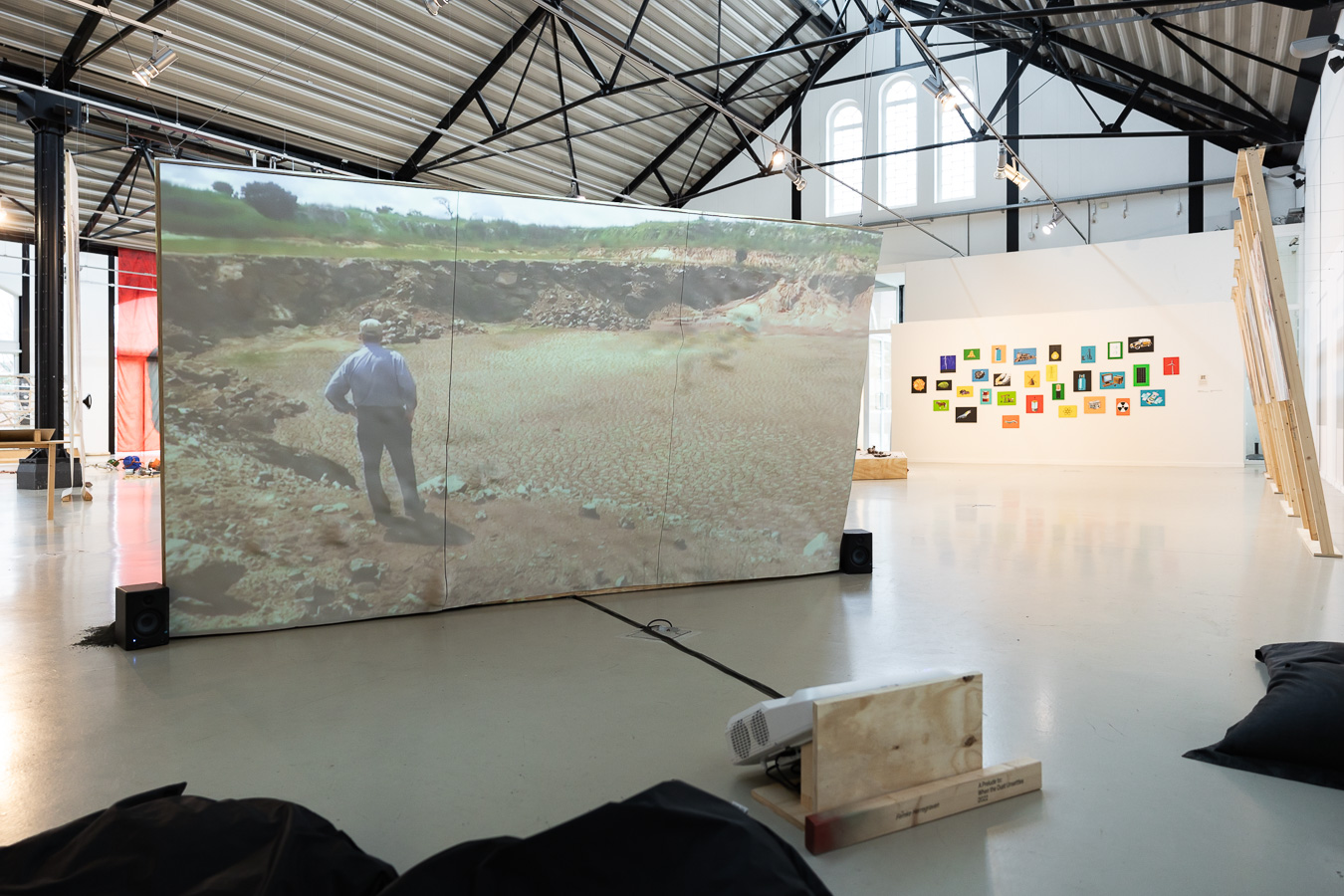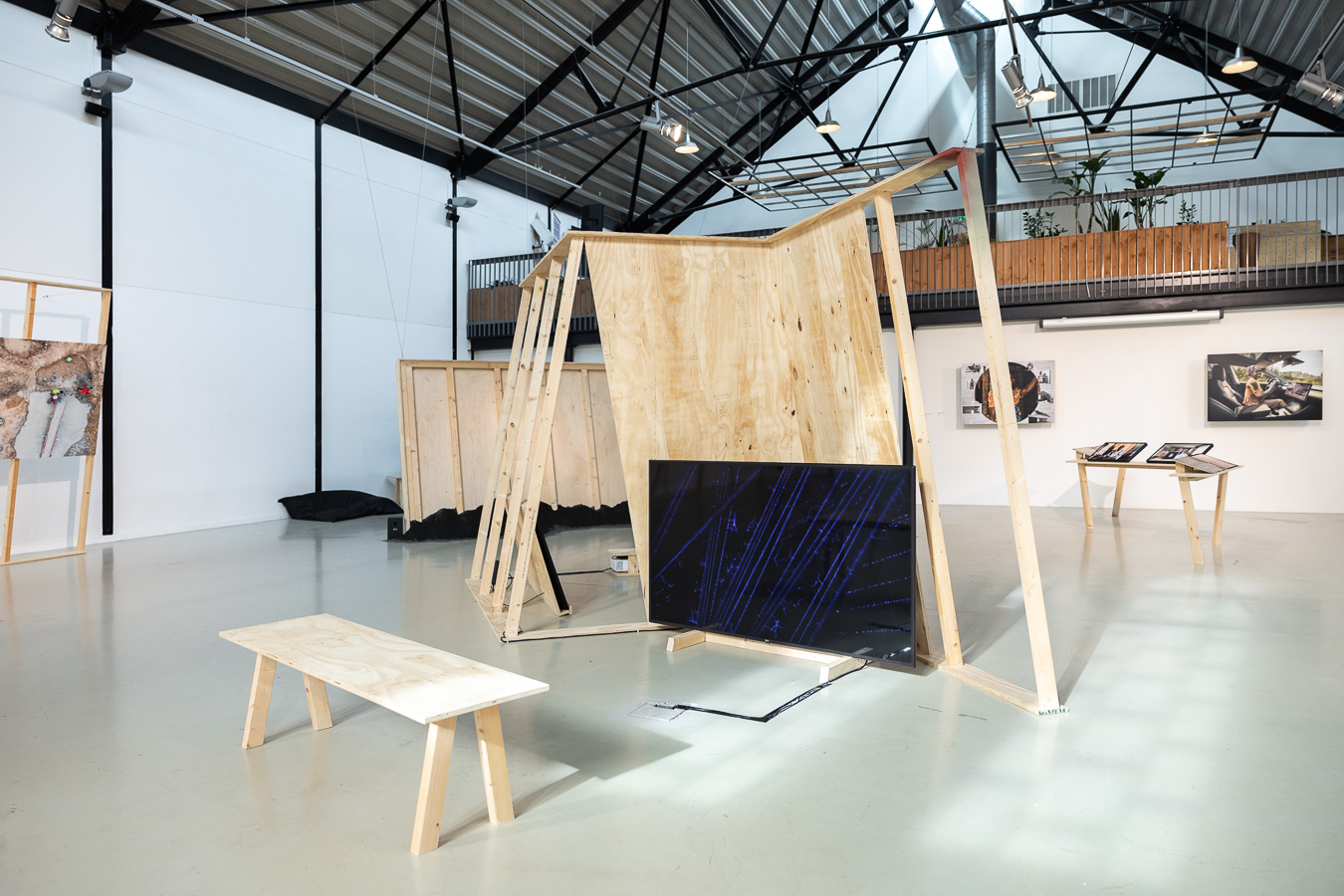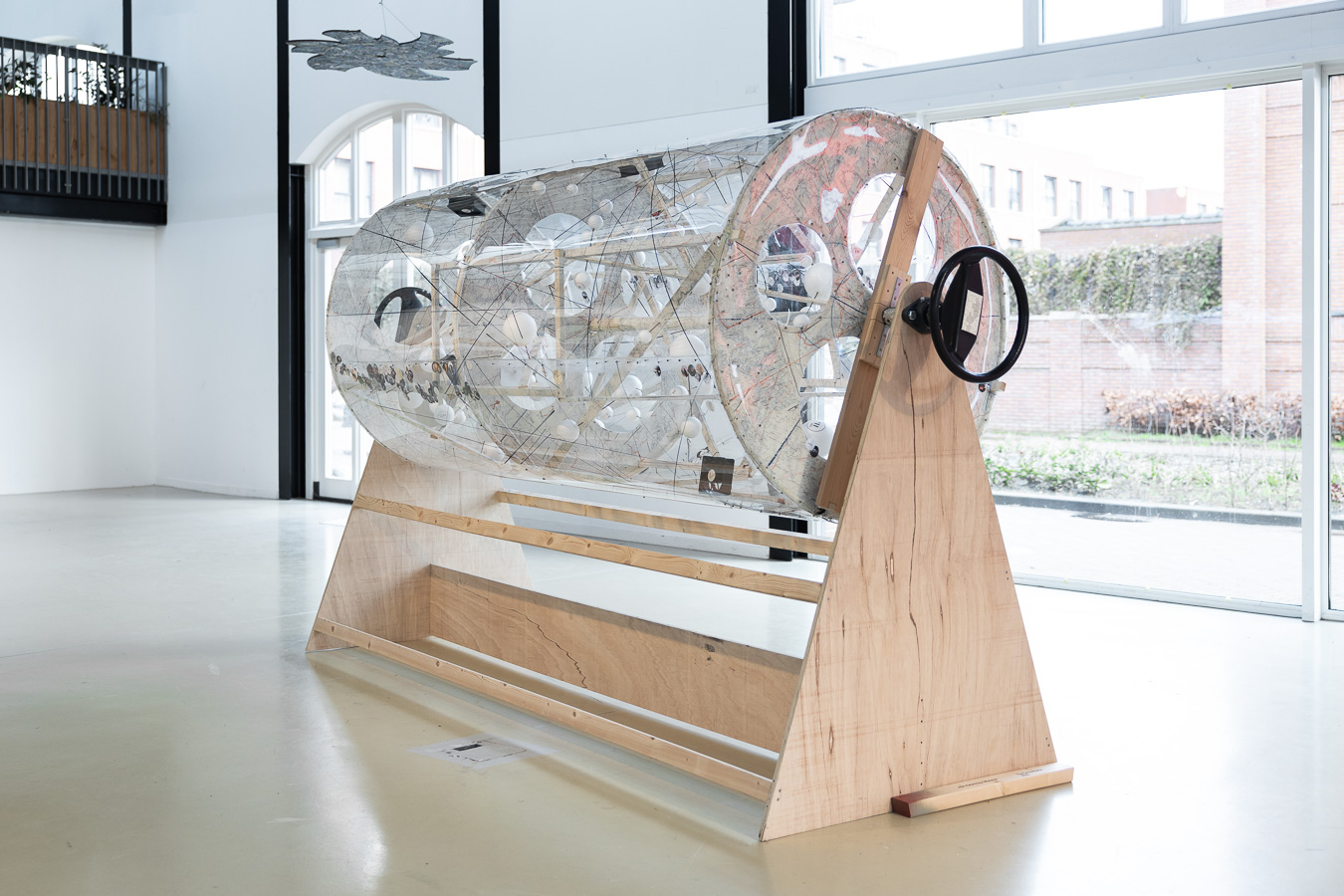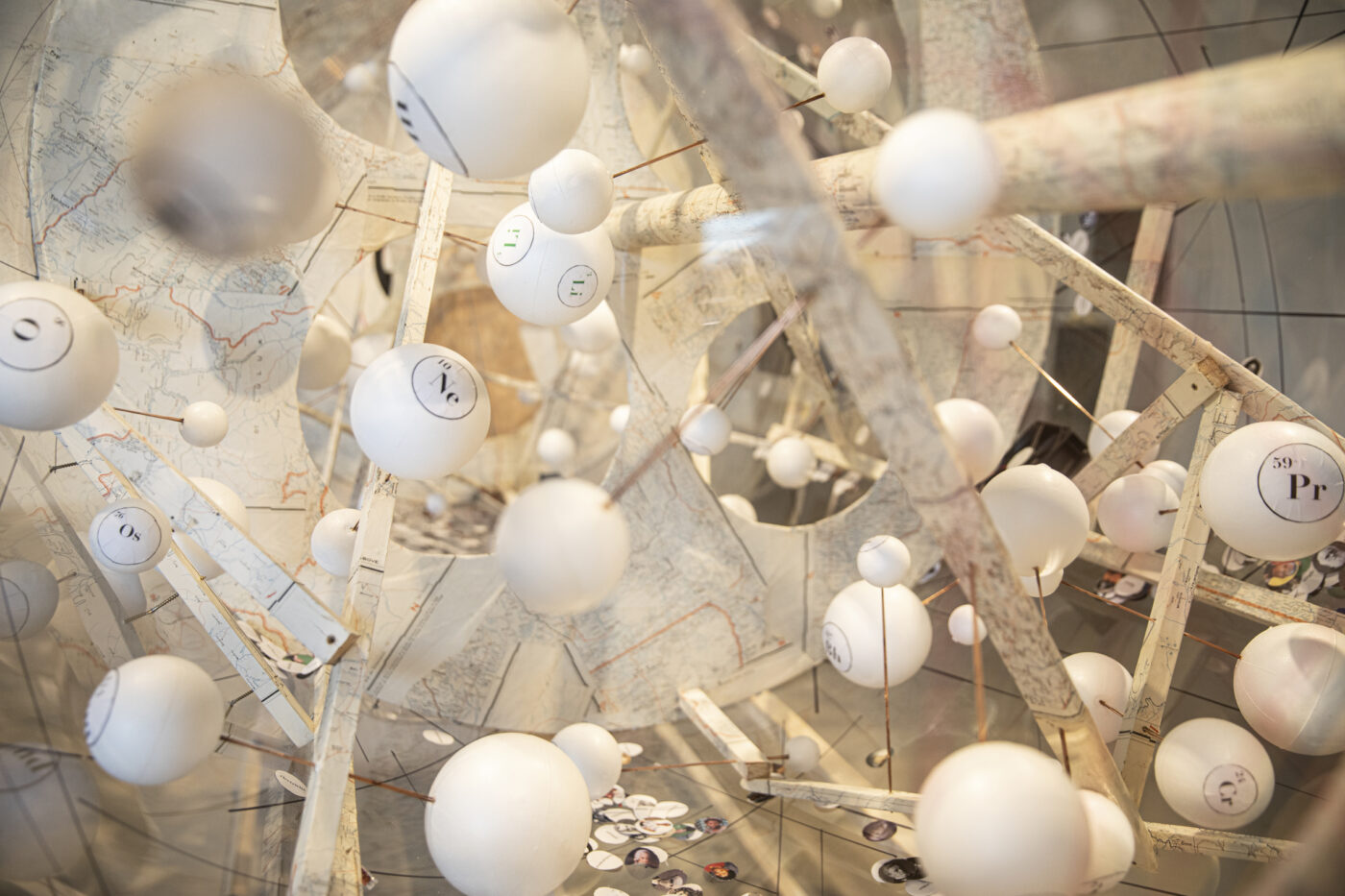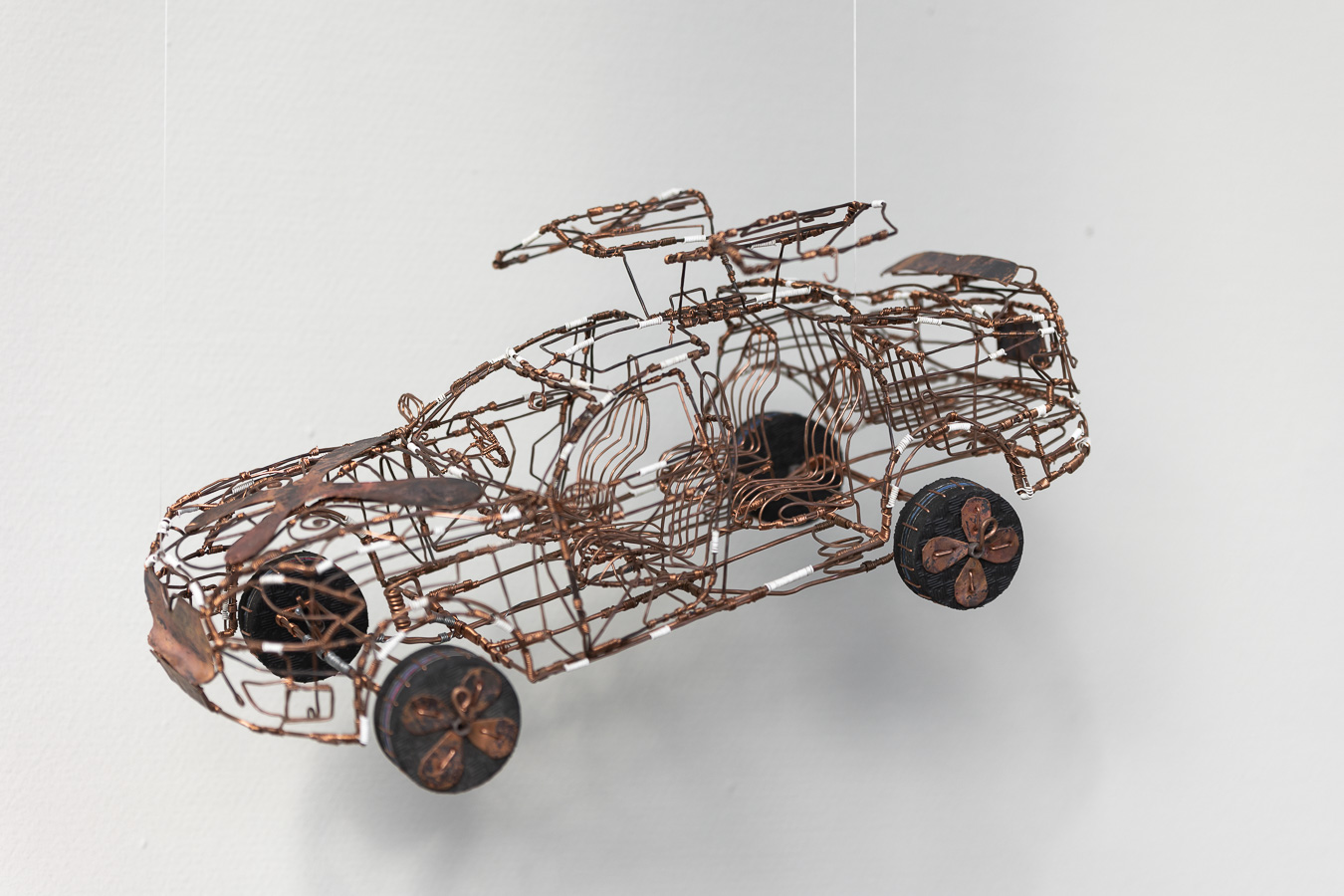Sacrificial Energy by Rose-Anne Gush
I traveled to Amsterdam with a group of students from IZK – Institute for Contemporary Art at Graz University of Technology, my colleague Philipp Sattler and friend, curator, Andrea Popelka, to view the exhibition Charging Myths by the artist collective On-Trade-Off and other configurations of artists and scholars critically investigating the energy transition. In our case, this research relates to an exploratory tunnel, dug 1.6km into the Koralm mountain range in the Austrian Alps, where lithium spodumene was found. European Lithium, a company headquartered in Australia, plans to make this mine (among others in the region) operational by early 2025, extracting the spodumene to send it for processing in Saudi Arabia. This review essay addresses the exhibition Charging Myths and its narrative of lithium extraction in relation to the global energy transition, its histories, social and material relations, and its aesthetic and political potential.
Text by: Rose-Anne Gush
I am interested in how the exhibition Charging Myths interrogates and materializes global energy culture, with lithium taking the heroic position in the name of the green revolution to rescue us in our battery dependency.³ Lithium’s history is bound up with its role as a remedy against bipolar disorder. As such, its presence in the earth has been historically used as the site of therapeutic bathing grounds. In drinking water, lithium is known to lower depression and suicide rates. In this vein, Anastasia Kubrak writes that just before the Wall Street crash in 1929, “lithiated” lemon soda became available on the market, sold as a mood enhancer, and with each minor and major depression, lithium served to restore our energies.⁴ While lithium continues to be activated against depression, its current role is now settled as a component of rechargeable batteries. Its importance is raised as whole continents of the world attempt to divest from fossil fuels; lithium is their replacement.⁵

Alexis Destoop, The Pits (2022). Photo: Maarten Nauw / Framer Framed
The works in Charging Myths explore how energy is economized and commodified. Alexis Destoop’s work, The Pits (2022), contains a video installation and print that hangs in the center of the space contributing to lithium’s origin myth. The print depicts a cross-section of a mineshaft on the Swedish island of Utö, where the first lithium deposits were found in the early 1800s. Utö’s mining history, or history of the pits, goes back more than 1000 years to times when Vikings extracted iron. Destoop modified an early nineteenth-century topographical etching, magnifying or enlarging the 25 cm (9.8 inch) image to 4,75 m (187 inches). With a lot of painstaking work, he erased, amplified and enhanced certain elements, creating a reappropriation.⁶ This radical upscaling is designed to challenge a normative top-down point of view that captures the earth’s surface in order to quantify and measure it. We are forced to look up as though we are in the belly of the pits, our gaze follows the dotted lines up to the surface.
As an extractable resource, energy is finite, which is part of its «myth.» Yet we also use the word energy to name intangible and capacious notions that connote life and liveliness, power, vigor, effort, force. In 1847, Hermann von Helmholtz published the essay, “Über die Erhaltung der Kraft”, which inaugurated energy’s present-day definition regarding its conservation, evident in the first law of thermodynamics. Cara New Daggett writes that “Thermodynamics mapped the new Earth through the figure of energy, a unit that retained its identity through time (energy conservation), even as its tendency to dissipate (entropy) imparted a tragic edge.”⁷ The entropic, the tragic aspect of finite, inevitably dissipating energy led to the anxiety that it needs fixing and recharging. The term energy then expanded to include a technical sense, and was, in the 1970s, conjoined to its pair, crisis. Kubrak notes that the 1970s energy crisis of gave rise to the invention of the rechargeable lithium battery, developed within ExxonMobil for the electric car⁸ – and soon after abandoned, to be renewed today in light of permanent wars, most notably taking place in Ukraine, and imminent climate collapse, in a large part due to burning fossil fuels.
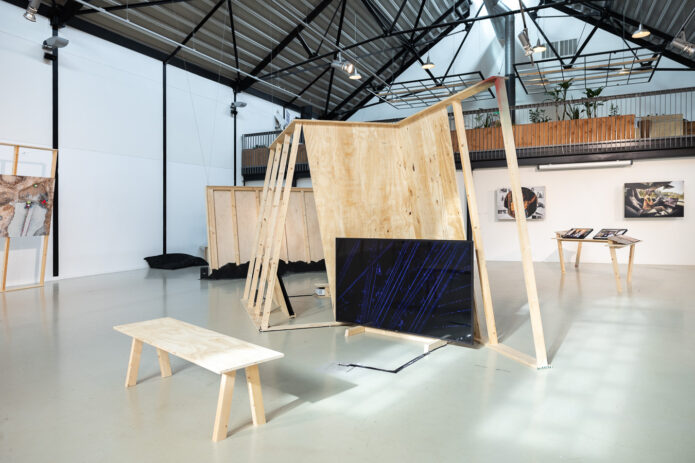
Marjolijn Dijkman, Depth of Discharge (2021). Photo: Maarten Nauw / Framer Framed
Femke Herregraven’s video work, A Prelude To: When the Dust Unsettles (2022) takes the images produced by the Australian mining company AVZ as digital model or «twin» of the exploratory tunnel in Manono, looking at how capitalized nature is rendered an ideal image. We see the extraction process, as demonstrated to convince investors of the promise of future profit, as a terra nullius, a landscape showing only minerals to be extracted. In this video, the real Manono landscape and the virtual model, a discrete sociotechnical object, are juxtaposed, introducing the difficult constraints of existent lifeforms that inhabit the land, and thus the inherent devastation that mining causes to its landscapes and the lives that occupy it. In its rendering of the digital twin, Herregraven’s video reflects the smoothness of the ideal energy landscapes, or what Jeff Diamanti terms “energyscapes”, the settings where capital finds its energy infrastructures optimized for capital’s growth.⁹ Yet the unevenness of the energy transition, as it is rendered in A Prelude To: When the Dust Unsettles, illuminates the geography of extraction that Martin Arboleda calls the “planetary mine”. For Arboleda, the novelty invoked by the word ‘planetary’ refers to the geography of industrialization decentered from the West, following Achille Mbembe’s claim that Europe has been provincialized as a center of capital; “Europe is no longer the center of gravity of the world,” Mbembe writes.¹⁰ Arboleda’s use of planetary also indicates a «quantum leap in the robotization and computerization of the labor process», culminating in what he calls the fourth machine age,¹¹ to describe technological modernization in the global South after the 1980s. In particular, he looks at East Asian economies which have destabilized such “metageographical categories”: core/periphery or global North/South, in turn significantly increasing technological innovations.¹² In this schema, the fourth machine age designates the fusing of technologies that produce this upscaling. Computerization, machine learning, biotechnology, and their utilization across all domains, physical, digital, biological etc. form the basis of Arboleda’s claim to this epochal shift. In sum, this shift signals the huge economic profitability of the smart or robotized mine, as well as, crucially, its carbon footprint – it produces more than a thousand times more solid waste.¹³ The planetary mine exceeds the mine as a “discrete sociotechnical object” – the object we explore in Manono – expanding into a network of infrastructures and spatial technologies.¹⁴ It traverses the entire geography of the earth. And it blurs the boundaries between “manufacturing and extraction, waste and resources, biologically and non-biologically based industries.” ¹⁵ Extraction goes beyond taking minerals from the earth. It expands to include logistics, transoceanic corridors, finance capital, labor. Mining becomes global supply chains, state powers, neo-imperialism and its dependencies, as illustrated by the abstraction in Herregraven’s video.
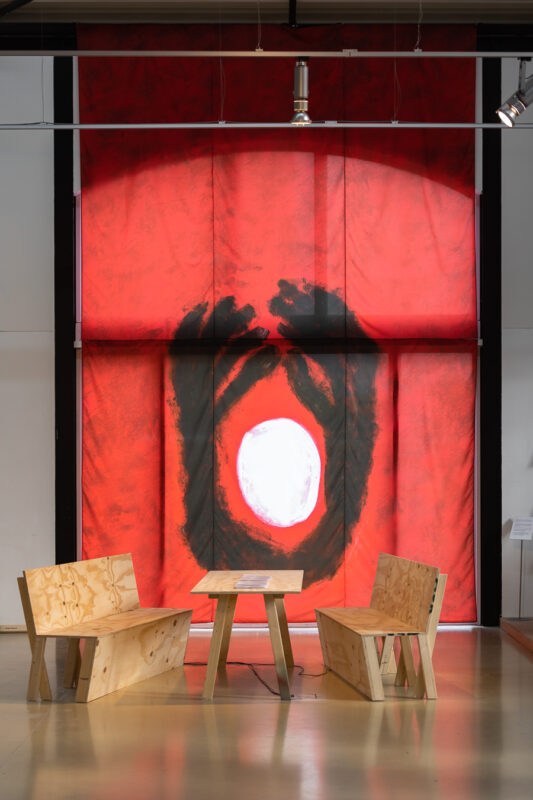
Pélagie Gbaguidi, Hunger (2022). Photo: Maarten Nauw / Framer Framed
The dialectical counterpart to such energyscapes seen in the DRC can be found in Georges Senga’s photographs, Tshanga-Tshanga (2022), shot by drones that look down on scarred landscapes functioning as artisanal mines, where subsistence miners work in mud with basic tools, independently of mining companies, on the grounds of former industrial mines. The withdrawal of corporations leaves a landscape where people are then forced to continue working in informal economies. The work Hunger (2022) by Pélagie Gbaguidi, as its title signals, indexes survival. Giant, ravenous, gaping mouths with flaring teeth make up a graphic display which overlays two benches that we are invited to sit on while we listen to the poem We Are a New Sun or read booklets available on the table. The poem was written after Gbaguidi traveled to Lubumbashi, where she worked with women subsistence miners who were extracting cobalt – a mineral that is also necessary for lithium-ion batteries – in devastating life-threatening conditions. Charging Myths is made up of materializations of energyscapes that speak, or scream silently, like these mouths. The mine in Manono, located 500 km away from Lubumbashi, like many of its kind, is both the site of historical extraction – in this case, since 1919, tin – and now the site of the promise of green energy. The exhibition takes this paradox, the fact that the transition to green energy demands the extraction of large swaths of nature, as its premise.

Installation of the exhibition Charging Myths (2023) at Framer Framed, Amsterdam. Photo: Maarten Nauw / Framer Framed
Likewise, addressing Tesla Inc, one of the biggest buyers and users of lithium batteries, Sammy Baloji, Jean Katambayi Mukendi and Daddy Tshikaya created a Tesla car made from copper wire, called Tesla Crash: A Speculation, a miniature version of which was hung in the entrance of Framer Framed. Musasa’s and Maarten Vanden Eynde’s Material Matters Li3 (2018) is a painting that appears as a didactic wall chart showing a symbolic map of lithium’s forms and symbols, from the mine to battery and the repeated Tesla motif adorned with wings. Marjolijn Dijkman’s Cloud to Ground #1 (2021) consists of a large, raised bed littered with fulgurites, «lightning tubes» made of sand after it has been struck by lightning. In Charging Myths, Dijkman’s tubes are artificial, made of soil from Belgian and Congolese mining areas. As such, they are energyscapes that are lit up and, more crucially, extinguished in the artwork. In relation to Cloud to Ground #1, the exhibition suggests an epistemic shift from historical materialism to considerations of matter and its energies that are symptomatic of a broader turn towards the ontologizing of matter within more than human life-forms (consider new materialism [Jane Bennet, Karan Barad], Object-Oriented Ontology [Graham Harman et al.], and Actor Network Theory [Bruno Latour et al.]). As objects are elevated as agential entities, this tendency often leads to a depoliticization of social relations. For example, the power of lithium to combust is part of its potential to sabotage or explode the objects it sits within. Yet – I want to argue that this potential auto-sabotage remains continuous with the social relations that have led to lithium being used in car batteries. I follow Diamanti’s argument that these philosophical tendencies (new materialism, OOO, ANT) are connected and “articulate a shared fantasy” whereby they constitute a “post-industrial philosophy that imagines capital as a form of energy,” cut off from of any relation to what it is underpinned by, its conditions of production, thus naturalizing it.¹⁶ Although the works in Charging Myths speak discretely through their matter, materiality and its potentials, their social and historical contexts envelop them, as energy and its infrastructures remain tethered to capitalist exploitation in its most virulent forms. Indeed, in a discussion hosted by Framer Framed, the artists described the challenge of the landscape in Manono as one of finding the human story, as it is submerged by the global corporate and state actors.¹⁷
In Aesthetic Theory, Theodor Adorno describes the artwork as a forcefield that materializes as a process of becoming. Interestingly, Adorno describes the parts that make an artwork as «centers of energy that strain toward the whole on the basis of a necessity that they equally perform.» He continues, “[t]he vortex of this dialectic ultimately consumes the concept of meaning”.¹⁸ Can we say that Charging Myths enacts this dialectic on a larger scale, wherein the totality of the exhibition enacts this work, as the parts materialize energy both literally and figuratively and problematize our relation to and dependency on it? Lithium itself produces a non-synchronous temporal image of energy, as we use and consume it.

Installation photo from the exhibition Charging Myths (2023) at Framer Framed, Amsterdam. Photo: Maarten Nauw / Framer Framed
One of the most interesting temporal images in Charging Myths is A Chain of Events (2021) by Maarten Vanden Eynde. Snaking through the gallery, a large chain links pieces of rope to bulky chunks of crystal, oversized buttons, painted beads, light bulbs, balls, cogs, and other objects that might speculatively be used both for barter and exchange or to measure or record information. This work speaks to the relation between lithium’s gigafactories, recorded on the information timeline also included in the exhibition, and the artisanal mines where Gbaguidi’s colleagues search for cobalt in mud. Chain of Events formally scatters the moments that exist simultaneously with each other. The work gives us a sense of multi-directional temporality: it is not simply that colonial enterprises laid the groundwork for neo-colonial corporations, there are also reversals and regressions. We know Lubumbashi is the site of colonial era copper mines set up by King Leopold that were later taken over by Union Miniere de Haut-Katanga and recently bought up by today’s global corporations that administer the planetary mine, using the remains of the infrastructures built within empire. But when the companies leave and discard their sites, out of necessity and survival, the sites are reverted to pre-industrial modes of operation by local populations.
The exhibition space, Framer Framed, describes itself as focusing on the “social and environmental impact of mines on our society.”¹⁹ The institution frames this in relation to the price that we pay, environmentally and ecologically, for our energy dependencies, and I would add, energy compulsions – are we brave enough to ask if we can live without these prosthetic devices into which we project ourselves? Through its geographic dialogue, the exhibition reveals the inverted reality of both the direct encounter with the site of extractive mining – after fossil fuels – and the consumption of the shiny surfaces of electronic end products: battery operated cars and devices. Charging Myths brings the mine into relation with the networks of relations that sprawl out from its mouth, spitting out the future of battery-operated devices, especially the car (as countries legislate targets for ending fossil-fueled cars), showing how this so-called renewable future comes at the cost of the devastation of the planet, and the continuous rotation of new suns.
Rose-Anne Gush
27th June 2023
Originally published by Brand-New-Life
I would like to thank Anastasia Kubrak and Lucie Kolb for their careful and astute editing.
-
- 1. Charging Myths was a co-production between Z33 (Hasselt, BE) and Framer Framed (Amsterdam, NL). “On-Trade-Off: Charging Myths — Announcements — e-Flux,” E-flux, accessed June 7, 2023.
- 2. The artist collective On-Trade-Off includes Alexis Destoop, Marjolijn Dijkman, Pélagie Gbaguidi, Femke Herregraven, Dorine Mokha & Elia Rediger, Jean Katambayi Mukendi, Musasa, Alain Nsenga, Georges Senga, Pamela Tulizo, Maarten Vanden Eynde.
- 3. Lithium is presented as the (tragic) hero of the present-day energy crisis that can get us out of our energy-addiction predicament, decreasing our CO2 emissions – as Cristobal Bonelli has described it.
- 4. Anastasia Kubrak, “From Burnout to 7UP: On Bathing and Mining Grounds,” in Lithium: States of Exhaustion, eds. Diaz, Kubrak, Verzier (Ediciones ARQ/Het Nieuwe Instituut, 2021), pp. 16–19, 17.
- 5. “Energy Strategy,” European Commission, accessed May 18, 2023.
- 6. My account relies on a correspondence with the artist. Alexis Destoop, The Pits, June 19, 2023.
- 7. Cara New Daggett, The Birth of Energy: Fossil Fuels, Thermodynamics, and the Politics of Work (Durham: Duke University Press Books, 2019), p. 11.
- 8. Kubrak, pp. 18-19.
- 9. Jeff Diamanti, Climate and Capital in the Age of Petroleum: Locating Terminal Landscapes (London: Bloomsbury Academic, 2021), p. 62.
- 10. Achille Mbembe, cited in, Martin Arboleda, Planetary Mine: Territories of Extraction under Late Capitalism (New York: Verso, 2020), p. 8.
- 11. Arboleda, p. 4. The history of capitalism is made up of imperial cores, and dependent peripheries, since the C16, experiencing resource booms.
- 12. Arboleda, p. 4.
- 13. Arboleda, p. 11.
- 14. ‘Planetary mine’ is a term that Arboleda borrows from Mazan Labban. Arboleda, p. 5.
- 15. Arboleda, p. 5.
- 16. Diamanti, p. 66.
- 17. Framer Framed, “#03 – More-Than-Human Encounters,” Framer Framed (podcast), accessed May 18, 2023, https://framerframed.nl/podcast.
- 18. Theodor W. Adorno, Aesthetic Theory, ed. Gretel Adorno and Rolf Tiedemann, trans. Robert Hullot-Kentor (London: Bloomsbury, 2013), p. 244.
19. Josien Pieterse and Evie Evans, “Introduction”, On-Trade-Off: Charging Myths — Catalogue (Amsterdam: Framer Framed, 2023), p. 5.
Ecology / Extractivism / Colonial history /
Exhibitions
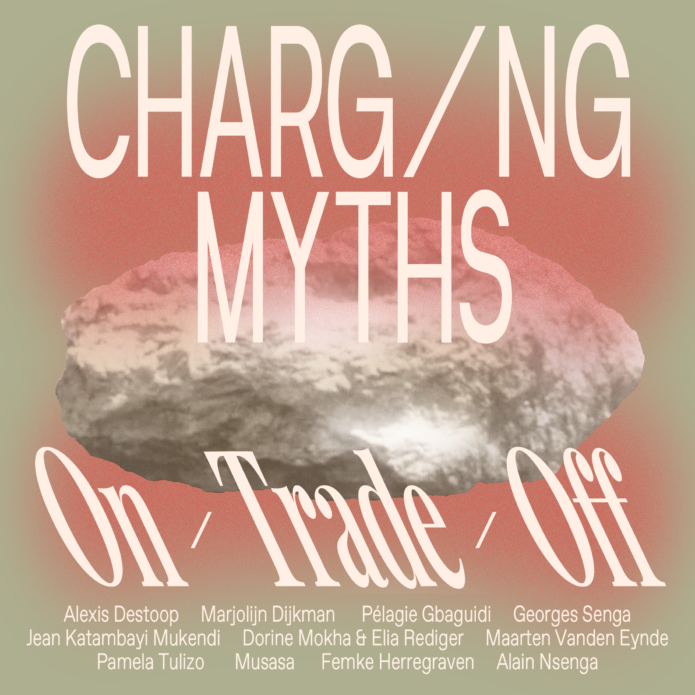
Exhibition: Charging Myths
An exhibition by transnational collective On-Trade-Off exploring how technological innovation is dependent on natural resources.
Network
Alexis Destoop
Artist

Marjolijn Dijkman
Artist

Femke Herregraven
Artist

Jean Katambayi Mukendi
Artist

Edmond Musasa Leu N’seya
Artist

Georges Senga
Artist
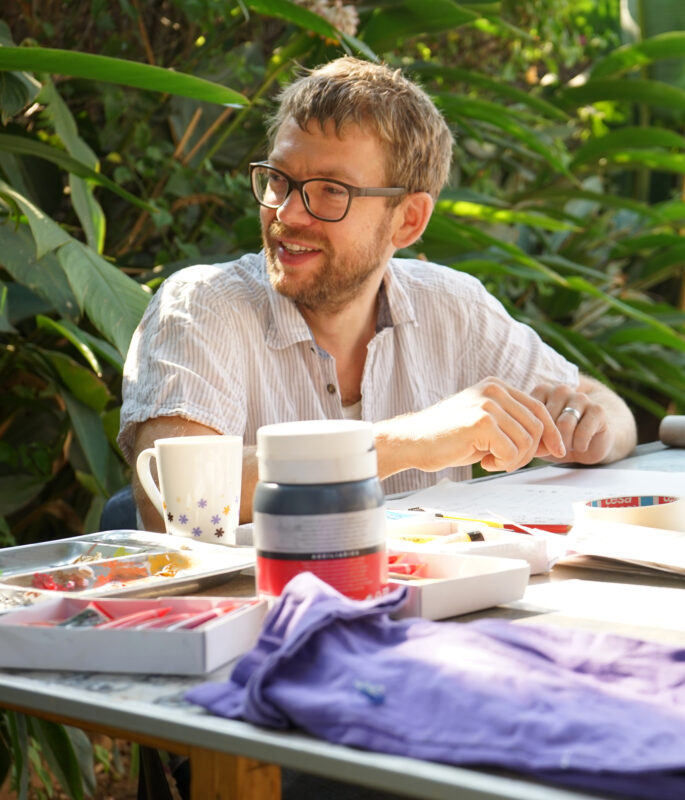
Maarten Vanden Eynde
Artist

